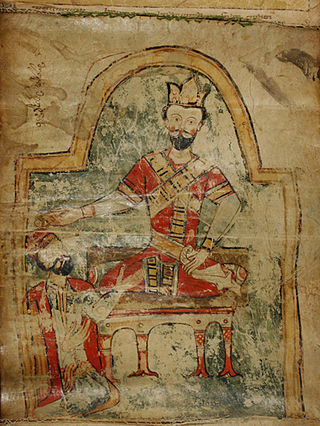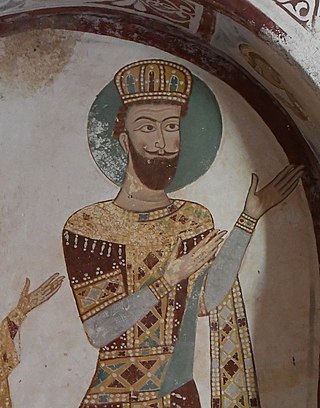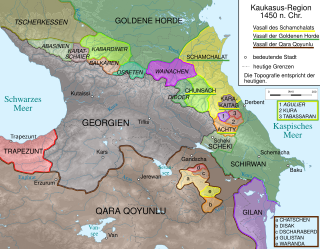Bagrat V the Great from the Bagrationi dynasty was the son of the Georgian king David IX of Georgia by his wife Sindukhtar Jaqeli. He was co-ruler from 1355, and became king (mepe) after the death of his father in 1360.

Constantine I was king (mepe) of Georgia from 1405 or 1407 until his death in 1412. He is the common ancestor of all surviving branches of the Bagrationi dynasty.

George VII of the Bagrationi dynasty, was king (mepe) of Georgia from 1393 to 1407. George put up a stiff resistance and had to spend much of his reign fighting against Timur.

George VIII of the Bagrationi dynasty, was de facto last king (mepe) of the formerly united Kingdom of Georgia from 1446 to 1465. He would later rule in the Kingdom of Kakheti as George I from 1465 until his death in 1476, founding a local branch of the Bagrationi dynasty.

Alexander II was a king (mepe) of Georgia in 1478 and of Imereti from 1483 to 1510.

The Tokhtamysh–Timur war was fought from 1386 to 1395 between Tokhtamysh, khan of the Golden Horde, and the warlord and conqueror Timur, founder of the Timurid Empire, in the areas of the Caucasus Mountains, Turkestan and Eastern Europe. The battle between Amir Timur and Tokhtamysh played a key role in the decline of Mongol power over early Russian principalities.

The Mongol invasions of Georgia, which at that time consisted of Georgia proper, Armenia, and much of the Caucasus, involved multiple invasions and large-scale raids throughout the 13th century. The Mongol Empire first appeared in the Caucasus in 1220 as generals Subutai and Jebe pursued Muhammad II of Khwarezm during the destruction of the Khwarezmian Empire. After a series of raids in which they defeated the combined Georgian and Armenian armies, Subutai and Jebe continued north to invade Kievan Rus'.

The Kingdom of Georgia, also known as the Georgian Empire, was a medieval Eurasian monarchy that was founded in c. 1008 AD. It reached its Golden Age of political and economic strength during the reign of King David IV and King Tamar the Great from the 11th to 13th centuries. Georgia became one of the pre-eminent nations of the Christian East, and its pan-Caucasian empire and network of tributaries stretched from Eastern Europe to Anatolia and northern frontiers of Iran, while Georgia also maintained religious possessions abroad, such as the Monastery of the Cross in Jerusalem and the Monastery of Iviron in Greece. It is the principal historical precursor of present-day Georgia.

Islam in Georgia was introduced in 654 when an army sent by the Third Caliph of Islam, Uthman, conquered Eastern Georgia and established Muslim rule in Tbilisi. Currently, Muslims constitute approximately 9.9% of the Georgian population. According to other sources, Muslims constitute 10-11% of Georgia's population.
George I, of the Bagrationi dynasty, was king of Western Georgia from 1389 to 1392.

The Samtskhe-Saatabago or Samtskhe Atabegate, also called the Principality of Samtskhe, was a Georgian feudal principality in Zemo Kartli, ruled by an atabeg (tutor) of Georgia for nearly three and a half centuries, between 1268 and 1625. Its territory consisted of the modern-day Samtskhe-Javakheti region and the historical region of Tao-Klarjeti.

The Kingdom of Kartli was a late medieval/early modern monarchy in eastern Georgia, centred on the province of Kartli, with its capital at Tbilisi. It emerged in the process of a tripartite division of the Kingdom of Georgia in 1478 and existed, with several brief intervals, until 1762 when Kartli and the neighbouring Georgian kingdom of Kakheti were merged through dynastic succession under the Kakhetian branch of the Bagrationi dynasty. Through much of this period, the kingdom was a vassal of the successive dynasties of Iran, and to a much shorter period Ottoman Empire, but enjoyed intermittent periods of greater independence, especially after 1747.

The Turkoman invasions of Georgia also Georgian–Turkoman wars, refers to invasions of various Muslim Turkoman tribes on the territory of the Kingdom of Georgia throughout the 15th century.

The Georgian–Seljuk wars, also known as Georgian Crusade, is a long series of battles and military clashes that took place from c. 1048 until 1213, between the Kingdom of Georgia and the different Seljuqid states that occupied most of Transcaucasia. The conflict is preceded by deadly raids in the Caucasus by the Turks in the 11th century, known in Georgian historiography as the Great Turkish Invasion.
The siege of Tbilisi was the successful siege of the city of Tbilisi, capital of the Kingdom of Georgia, by the Turco-Mongol conqueror Timur, which ended on 22 November 1386. The official history of his reign, Zafarnama, represents this invasion in Georgia as a jihad.

The Timurid conquests and invasions started in the seventh decade of the 14th century with Timur's control over Chagatai Khanate and ended at the start of the 15th century with the death of Timur. Due to the sheer scale of Timur's wars, and the fact that he was generally undefeated in battle, he has been regarded as one of the most successful military commanders of all time. These wars resulted in the supremacy of Timur over Central Asia, Persia, the Caucasus, the Levant, and parts of South Asia and Eastern Europe, and also the formation of the short-lived Timurid Empire.
The High Middle Ages, or Classic Feudalism Period in what constitutes the present-day Republic of Azerbaijan, lasted from around the 11th century to the 15th century AD. The High Middle Ages were preceded by the Early Middle Ages and were followed by the Late Middle Ages, which ended around the 15thcentury AD. Key historical trends of the High Middle Ages include the incorporation of the territories that constitute present-day Azerbaijan into the Seljuk Empire, the establishment of the Eldiguzids, the Mongol invasions and the rule of the Ilkhanate, the invasions of Timur and the establishment of the Turkoman Kara Koyunlu and Aq Qoyunlu tribal confederations.

The collapse of the Georgian realm was a political and territorial fragmentation process that resulted in the dynastic triumvirate military conflict of the Bagrationi monarchs and war of succession in the united Kingdom of Georgia culminating during the second half of the 15th century.

The Kingdom of Western Georgia was a late medieval de facto independent fragmented part of the Kingdom of Georgia that emerged during the Mongol invasions of the realm, led by King David VI Narin in 1259 and later followed by his successors. During this period, the Kingdom of Georgia (1256-1329) was reduced to the eastern part of the country and placed under Mongol control. Over the decades, the monarchy would fall into chaos and transform into a federation of autonomous principalities unruly of the central or regional royal power and authority.
The Timur's South Georgian campaign was a invasion led by Timur and Ibrahim I of Shirvan against George VII of Georgia in retaliation for George's role in the siege of Alinja.

















